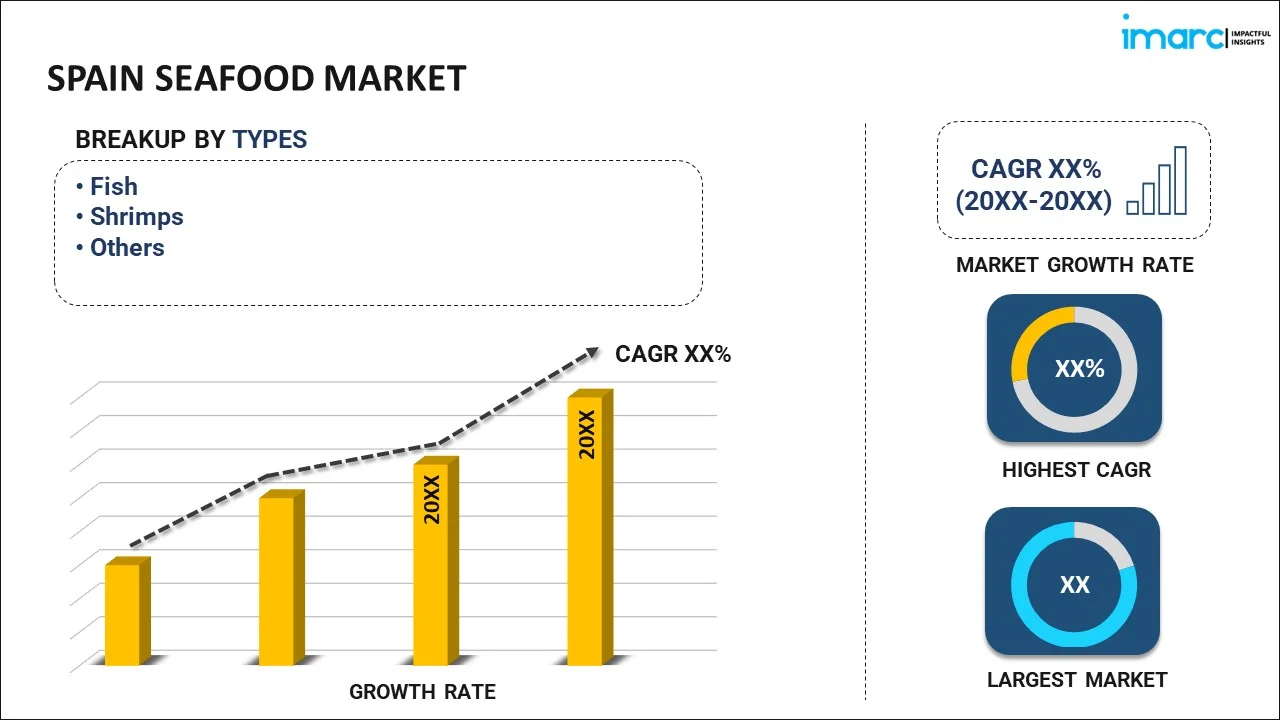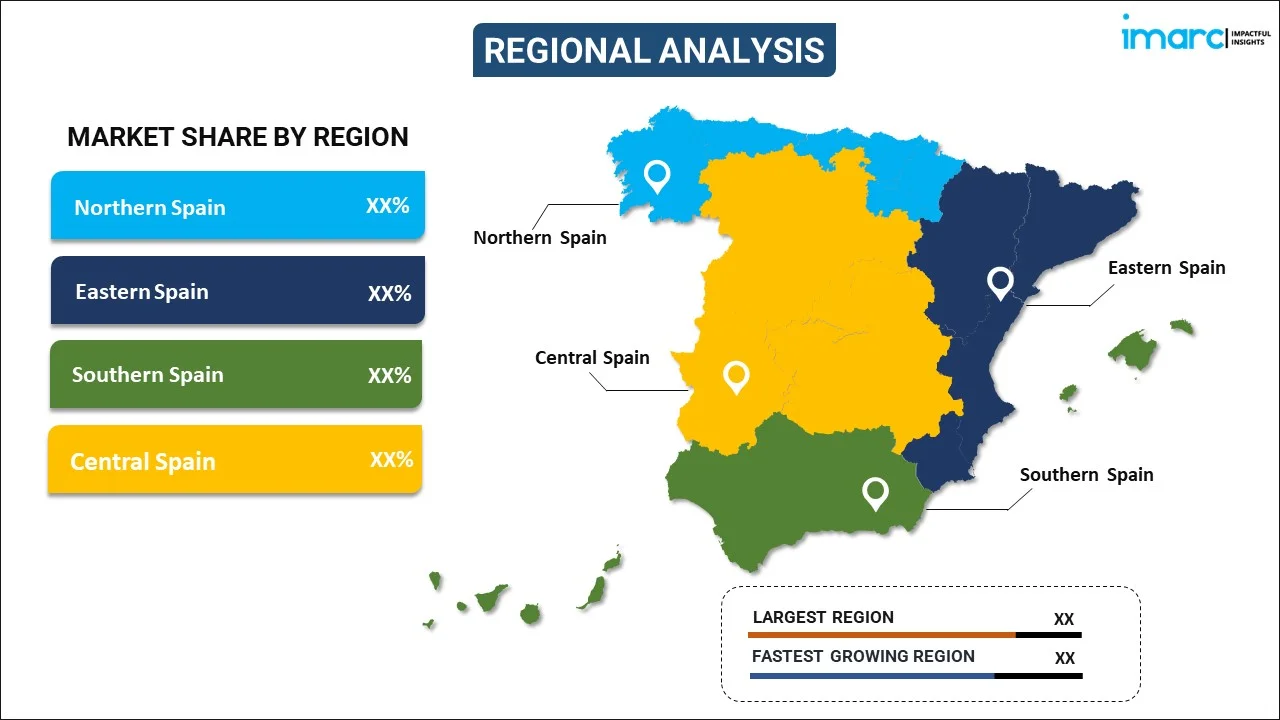
Spain Seafood Market Report by Type (Fish, Shrimps, and Others), Form (Fresh/Chilled, Frozen/Canned, Processed), Distribution Channel (Off Trade, On Trade), and Region 2025-2033
Spain Seafood Market Overview:
The Spain seafood market size reached USD 6.0 Billion in 2024. Looking forward, IMARC Group expects the market to reach USD 7.8 Billion by 2033, exhibiting a growth rate (CAGR) of 3.07% during 2025-2033. Sustainable sourcing, technological advancements, government regulations, culinary tourism, cultural traditions, efficient distribution networks, Spain's strategic location, and sustainable fishing practices are factors propelling the market growth.
|
Report Attribute
|
Key Statistics
|
|---|---|
|
Base Year
|
2024 |
|
Forecast Years
|
2025-2033
|
|
Historical Years
|
2019-2024
|
| Market Size in 2024 | USD 6.0 Billion |
| Market Forecast in 2033 | USD 7.8 Billion |
| Market Growth Rate (2025-2033) | 3.07% |
Spain Seafood Market Trends:
Extensive Coastline and Diverse Marine Ecosystems
Another critical driver of Spain’s seafood market is its extensive coastline covering over 7,900 kilometers along the Atlantic Ocean and the Mediterranean Sea. This huge expanse of coastline is the gateway to various marine ecosystems with a variety of seafood species. The North Atlantic is abundant in species such as cod, hake, and mackerel, whereas the Mediterranean is rich in shellfish species, including shrimp, clams, and mussels. This means that Spain can harvest a broad range of aquatic products, which doesn’t just satisfy the tastes of all individuals, but also offer considerable amounts of exports. Furthermore, the close distance to the fishing spots minimizes expenses related to the transportation of said aquatic products and also guarantees their freshness. As per the industry reports, in 2022, Spain’s imports of seafood products from all origins were $9.6 billion, up 7.6 percent from 2021.
Culinary Tradition and Gastronomy
The Spanish seafood market is an essential part of one of its most valuable aspects, its cuisine. Following the nationally recognized tradition of gastronomy and culinary experiences, seafood takes an essential role in the Spanish national diet. One only needs to mention iconic Spanish dishes like paella or seafood tapas for the cultural importance of seafood to become clear. Traditional seafood recipes are frequently ancient and have been passes down through generations; they always use fresh, locally caught seafood to make it a vital part of the Spanish daily table and an unwritten rule of a festive occasion. Being such traditionally significant part of national gastronomy, seafood is not only highly consumed within Spain but also a significant monitor for the country’s international food supply. Seafood consumption is one of the most important reasons for coming to Spain for many tourists, as traditional foods like paella have become popular worldwide.
Strong Fishing Industry
The strength of Spain's fishing industry is a key driver of its seafood market, characterized by a combination of modern fishing fleets and traditional artisanal fishing communities. Spain boasts one of the largest fishing fleets in the European Union, equipped with advanced technology and sustainable fishing practices. This enables efficient harvesting and processing of seafood, ensuring a steady supply of high-quality products to meet market demand. Additionally, traditional fishing methods practiced by coastal communities contribute to the preservation of local fishing heritage and sustainable resource management. These communities often employ selective fishing techniques that minimize environmental impact and support the conservation of marine biodiversity. The industry is further supported by robust infrastructure, including well-developed ports, processing facilities, and distribution networks, which facilitate the swift and efficient movement of seafood from sea to market.
Spain Seafood Market News:
- In 2024, the Nueva Pescanova Group was declared the most sustainable and responsible fishing company and the second in the global seafood sector. This Index is elaborated by the World Benchmarking Alliance (WBA) and measures the contribution of the 30 most influential companies in the seafood sector in terms of sustainability.
Spain Seafood Market Segmentation:
IMARC Group provides an analysis of the key trends in each segment of the market, along with forecasts at the country level for 2025-2033. Our report has categorized the market based on type, form, and distribution channel.
Type Insights:

- Fish
- Shrimps
- Others
The report has provided a detailed breakup and analysis of the market based on the type. This includes fish, shrimps, and others.
Form Insights:
- Fresh/Chilled
- Frozen/Canned
- Processed
A detailed breakup and analysis of the market based on the form have also been provided in the report. This includes fresh/chilled, frozen/canned, and processed.
Distribution Channel Insights:
- Off Trade
- On Trade
The report has provided a detailed breakup and analysis of the market based on the distribution channel. This includes off trade and on trade.
Regional Insights:

- Northern Spain
- Eastern Spain
- Southern Spain
- Central Spain
The report has also provided a comprehensive analysis of all the major regional markets, which include Northern Spain, Eastern Spain, Southern Spain, and Central Spain.
Competitive Landscape:
The market research report has also provided a comprehensive analysis of the competitive landscape. Competitive analysis such as market structure, key player positioning, top winning strategies, competitive dashboard, and company evaluation quadrant has been covered in the report. Also, detailed profiles of all major companies have been provided.
Spain Seafood Market Report Coverage:
| Report Features | Details |
|---|---|
| Base Year of the Analysis | 2024 |
| Historical Period | 2019-2024 |
| Forecast Period | 2025-2033 |
| Units | Billion USD |
| Scope of the Report | Exploration of Historical Trends and Market Outlook, Industry Catalysts and Challenges, Segment-Wise Historical and Future Market Assessment:
|
| Types Covered | Fish, Shrimps, Others |
| Forms Covered | Fresh/Chilled, Frozen/Canned, Processed |
| Distribution Channels Covered | Off Trade, On Trade |
| Regions Covered | Northern Spain, Eastern Spain, Southern Spain, Central Spain |
| Customization Scope | 10% Free Customization |
| Post-Sale Analyst Support | 10-12 Weeks |
| Delivery Format | PDF and Excel through Email (We can also provide the editable version of the report in PPT/Word format on special request) |
Key Questions Answered in This Report:
- How has the Spain seafood market performed so far and how will it perform in the coming years?
- What has been the impact of COVID-19 on the Spain seafood market?
- What is the breakup of the Spain seafood market on the basis of type?
- What is the breakup of the Spain seafood market on the basis of form?
- What is the breakup of the Spain seafood market on the basis of distribution channel?
- What are the various stages in the value chain of the Spain seafood market?
- What are the key driving factors and challenges in the Spain seafood?
- What is the structure of the Spain seafood market and who are the key players?
- What is the degree of competition in the Spain seafood market?
Key Benefits for Stakeholders:
- IMARC’s industry report offers a comprehensive quantitative analysis of various market segments, historical and current market trends, market forecasts, and dynamics of the Spain seafood market from 2019-2033.
- The research report provides the latest information on the market drivers, challenges, and opportunities in the Spain seafood market.
- Porter's five forces analysis assist stakeholders in assessing the impact of new entrants, competitive rivalry, supplier power, buyer power, and the threat of substitution. It helps stakeholders to analyze the level of competition within the Spain seafood industry and its attractiveness.
- Competitive landscape allows stakeholders to understand their competitive environment and provides an insight into the current positions of key players in the market.
Need more help?
- Speak to our experienced analysts for insights on the current market scenarios.
- Include additional segments and countries to customize the report as per your requirement.
- Gain an unparalleled competitive advantage in your domain by understanding how to utilize the report and positively impacting your operations and revenue.
- For further assistance, please connect with our analysts.
 Inquire Before Buying
Inquire Before Buying
 Speak to an Analyst
Speak to an Analyst
 Request Brochure
Request Brochure
 Request Customization
Request Customization




.webp)




.webp)












